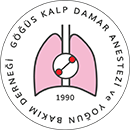

Volume: 31 Issue: 1 - 2025
| OTHER | |
| 1. | Front Matter Pages I - XII (246 accesses) |
| REVIEW | |
| 2. | Intraoperative Massive Hemorrhage and Management in Thoracic Surgery Nur Nazire Yucal, Tülay Çardaközü doi: 10.14744/GKDAD.2025.64872 Pages 1 - 6 (281 accesses) Massive hemorrhage (MH) is most commonly seen in acute trauma, complex cardiac surgery, obstetric hemorrhage, and coagulopathic patients. However, it can also occur during any intraoperative event and remains one of the greatest challenges for anesthesiologists. Major intraoperative bleeding is less common in thoracic surgery than in the past. The use of minimally invasive surgical techniques and the widespread implementation of patient blood management strategies starting from the preoperative period can be considered among the contributing factors. Although the incidence of MH in thoracic surgery is low, its mortality rate is high. Massive airway bleeding (hemoptysis) and major vascular injuries have been identified as conditions with a high risk of MH. In thoracic surgery, MH is a rare but life-threatening condition. Effective communication between the operating room team and the blood bank, along with a well-organized approach, is crucial. Ensuring adequate intravenous access during MH is a priority. Additionally, patient positioning should be carefully managed to increase preload and cerebral perfusion. Intraoperative MH is a rare but highly fatal condition in thoracic surgery. |
| RESEARCH ARTICLE | |
| 3. | Evaluation of Different Risk Scores in Coronary Artery Bypass Grafting Surgery Ecem Kolcu Kuğu, Şefika Türkan Kudsioğlu, Osman Ekinci, İbrahim Musab Köşker doi: 10.14744/GKDAD.2025.45712 Pages 7 - 14 (196 accesses) Objectives: This study aimed to compare the European System for Cardiac Operative Risk Evaluation (EuroSCORE) II and the Age-Creatinine Ejection Fraction (ACEF) II scoring systems in adult patients undergoing elective coronary artery bypass grafting (CABG) surgery and to determine the contribution of obesity to mortality and morbidity. Methods: A total of 175 patients over 18 years of age scheduled for elective isolated CABG surgery were randomly included in this prospective observational study. Demographic data, comorbidities, weight and height measurements, results of transthoracic echocardiography, and pulmonary function tests were recorded in the anesthesia outpatient or inpatient clinic. EuroSCORE II and ACEF II risk scores were obtained. The postoperative 30-day mortality of the study participants was recorded. Results: The mean age was 60±12 years, and 24% (n=42) of the patients were female. The postoperative 30-day mortality rate was 3.4% (n=6). Chronic obstructive pulmonary disease, low creatinine clearance, and high creatinine levels were significantly associated with postoperative 30-day mortality (all p-values < 0.050). According to ROC analysis, EuroSCORE II (area under the curve [AUC]=0.675) and ACEF II (AUC=0.551) were not sensitive predictors, whereas body mass index (BMI) demonstrated better predictive ability (AUC=0.709) for postoperative 30-day mortality. The postoperative 30-day mortality correlated positively with EuroSCORE II and ACEF II but negatively with BMI. The postoperative 30-day mortality in patients with high EuroSCORE II and high ACEF II was 5% (n=6) and 4.3% (n=6), respectively. Conclusion: BMI was a potentially good predictive factor for postoperative 30-day mortality. The postoperative 30-day mortality correlated positively with EuroSCORE II and ACEF II and negatively with BMI. |
| 4. | Focused Educational Programs Make a Significant Difference in Applications of Blood Management Aslıhan Aykut, Muhammed Talha Daşgın, Hülya Yiğit, Zeliha Aslı Demir, Nevriye Salman, Ümit Karadeniz doi: 10.14744/GKDAD.2025.16443 Pages 15 - 21 (211 accesses) Objectives: Bleeding and transfusion in cardiac surgery are serious complications that negatively impact patient outcomes, increasing morbidity, mortality, and costs. This study aimed to determine the changes in blood product usage and patient outcomes in our clinic following the introduction of patient blood management (PBM), component therapy training, and viscoelastic testing. Methods: Between January 2021 and June 2024, demographic, intraoperative, and postoperative data of patients undergoing open-heart surgery with intraoperative blood loss of at least 1000 mL and requiring red blood cell (RBC) transfusion were retrospectively reviewed. In our clinic, the use of rotational thromboelastometry (ROTEM) was initiated in January 2023, alongside simultaneous training in PBM and component therapy. Patients operated on before (Group B) and after (Group A) this date were divided into two groups, and patient outcomes were compared. Results: A total of 267 patients were included in the study. There was a significant increase in the use of fibrinogen, prothrombin complex concentrate (PCC), and autologous blood transfusion in Group A (p=0.017, p=0.006, and p=0.033, respectively). Postoperative complications and mortality rates were similar between the two periods. Conclusion: PBM algorithms recommend targeted and individualized treatments. The use of fibrinogen concentrate, PCC, and tranexamic acid has increased with the implementation of ROTEM-guided blood transfusion algorithms and training in recurrent PBM and component therapy. |
| 5. | The Prognostic Power of Albumin: A Key to Mortality Prediction in Open-heart Surgery Burak Toprak, Çise Kanat Toprak doi: 10.14744/GKDAD.2025.33230 Pages 22 - 31 (147 accesses) Objectives: This study aims to evaluate the impact of preoperative and postoperative albumin levels on mortality in open-heart surgery patients, investigating albumin as a predictive biomarker. Identifying such markers could improve perioperative management by enabling early risk stratification and personalized postoperative care for high-risk individuals. Methods: A retrospective analysis was conducted on patients undergoing open-heart surgery at Mersin University Faculty of Medicine between February 2021 and December 2022. Data collected included demographic information, comorbidities, and biochemical markers such as albumin, urea, creatinine, and inflammatory markers. Multivariate logistic regression was used to analyze the relationship between albumin levels and mortality, adjusting for potential confounders. Results: Among 450 patients, those with lower albumin levels pre- and post-surgery had a significantly higher risk of mortality. Elevated postoperative creatinine and urea, along with increased inflammatory markers, were also associated with worse outcomes. These findings suggest that hypoalbuminemia contributes to fluid imbalance and delayed healing, increasing mortality risk in open-heart surgery patients. Conclusion: Hypoalbuminemia, both preoperatively and postoperatively, is a strong predictor of mortality in open-heart surgery patients. Regular monitoring of albumin levels may reduce complications and improve survival rates. Albumin serves as a cost-effective biomarker for guiding personalized perioperative care, potentially improving outcomes in high-risk surgical patients. |
| 6. | Bedside Ductal Clipping in the Neonatal Intensive Care Unit: A Single-centre Experience Pınar Özdemir Yaşar, Şafak Alpat, Timuçin Sabuncu, Hasan Tolga Çelik, Başak Akça, Mustafa Yılmaz doi: 10.14744/GKDAD.2025.53486 Pages 32 - 37 (152 accesses) Objectives: Patent ductus arteriosus is a common problem in preterm neonates and may lead to pulmonary hypertension, heart failure, and neurodevelopmental disorders in the long term if not treated in time. Bedside PDA clipping in the neonatal intensive care unit is crucial for achieving satisfactory outcomes. However, the ideal anesthetic management to ensure optimal results remains debatable. Herein, we report our units anesthetic management and surgical outcomes. Methods: Between January 2023 and September 2024, 10 neonates underwent bedside ductal clipping at our unit. Relevant information, including preoperative, operative, and early postoperative data, was retrospectively collected. Results: A total of 10 patients, with a median age of 33.5 days (2755.5 days) and a median weight of 1297.5 g (1088.752350 g), were included in the study. The median total surgical time, from skin incision to closure, was 41.5 minutes (30.549 minutes). All patients were monitored with NIRS in addition to standard monitoring. There was no operative mortality, and postoperative recovery was uneventful. One patient died during hospitalization due to sepsis. The remaining patients stayed a median of 35 days (1536.75 days) after PDA clipping before discharge. Conclusion: We concluded that close monitoring of vital parameters, including near-infrared spectroscopy, is of utmost importance for the early detection of intraoperative complications. Thus, we achieved satisfactory early outcomes. However, the long-term neurodevelopmental consequences must be monitored. |
| 7. | Diaphragm Paralysis After Congenital Heart Surgery: A Single Center Experience Emine Hekim Yılmaz, Murat Çiçek doi: 10.14744/GKDAD.2025.57983 Pages 38 - 46 (204 accesses) Objectives: Phrenic nerve injury following congenital heart surgery has become the most common cause of diaphragm paralysis in children. In this single-center study, we aimed to determine the incidence of diaphragm paralysis after congenital heart surgery and to identify the risk factors for prolonged mechanical ventilation in this unique patient population. Methods: We retrospectively reviewed the records of all patients diagnosed with diaphragmatic paralysis after congenital heart surgery between January 2018 and May 2023. Results: The incidence of diaphragm paralysis was 3.13%. The median age and weight of the patients were 2.5 (IQR: 0.37) months and 4.2 (IQR: 3.27.25) kg. The median duration of mechanical ventilation was 10 (IQR: 528) days. Mechanical ventilation was prolonged in 30 (34.1%) patients. Infection, chylothorax, ECMO requirement, and unplanned cardiac reintervention significantly increased the risk of prolonged mechanical ventilation (p<0.05). After initial surgery, 50% underwent diaphragm plication at a median of 18 days (IQR: 1227.5 days). In this group, infection, chylothorax, and late plication (>14 days) increased the risk of prolonged mechanical ventilation (p<0.05). The time between diaphragm plication and index surgery was significantly longer in cases with prolonged mechanical ventilation (p<0.05). Conclusion: Phrenic nerve injury can cause significant morbidity after congenital heart surgery. The relationship between diaphragm paralysis and prolonged mechanical ventilation may have enormous clinical implications. Some patients may recover with conservative strategies; however, others require plication. Therefore, tailoring management strategies according to the patient's age, clinical condition, and need for positive pressure ventilation may help improve outcomes. |
| CASE REPORT | |
| 8. | Thoracic Segmental Spinal Anesthesia for Awake Video-assisted Thoracoscopic Surgery: A Case Report Nezir Yılmaz, Ubeydullah Aslan, Erkan Atlamaz doi: 10.14744/GKDAD.2025.32068 Pages 47 - 50 (215 accesses) Awake video-assisted thoracic surgery (VATS) using thoracic spinal anesthesia is a promising alternative to traditional general anesthesia, especially for patients with comorbidities. We report a case of a 72-year-old male with diabetes, hypertension, and coronary artery disease who underwent successful awake VATS for massive pleural effusion. A single-shot T6-T7 spinal injection with isobaric bupivacaine and fentanyl provided effective sensory blockade (T1-T10) without additional sedatives. The procedure was well tolerated, with no complications. Thoracic spinal anesthesia offers simplicity, rapid onset, and the avoidance of intubation-related risks, making it a viable option for selected patients. |

















